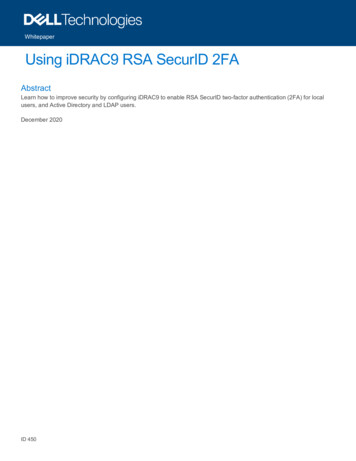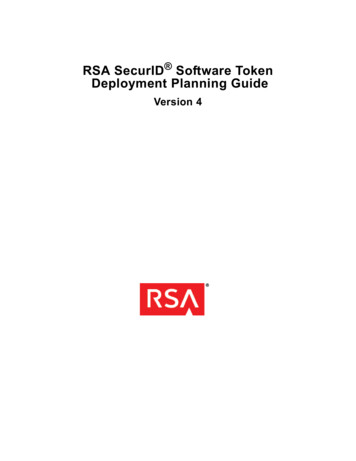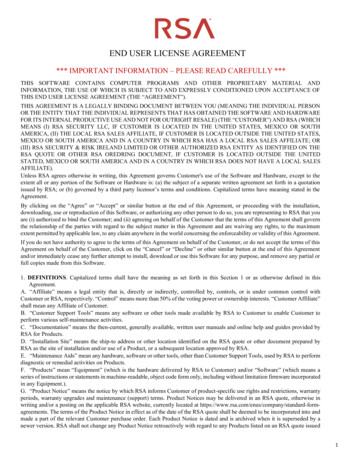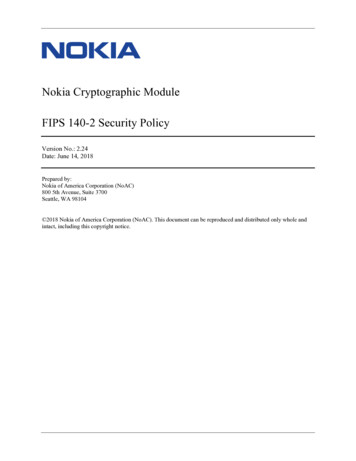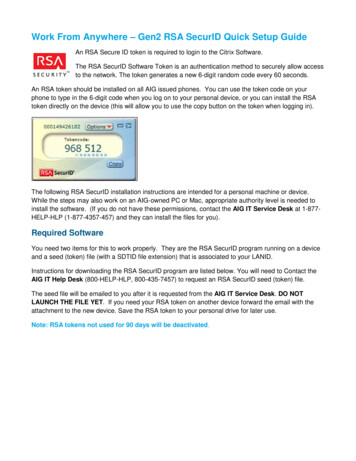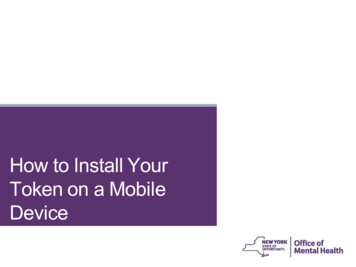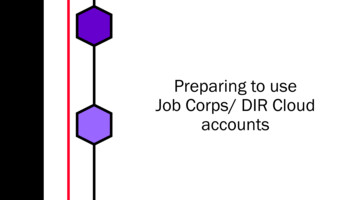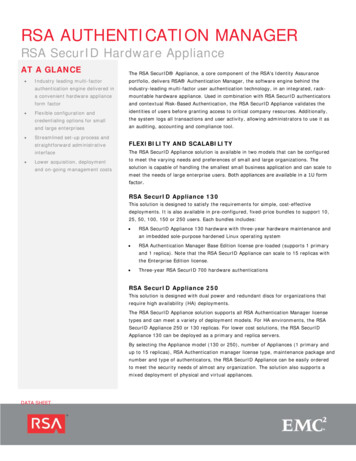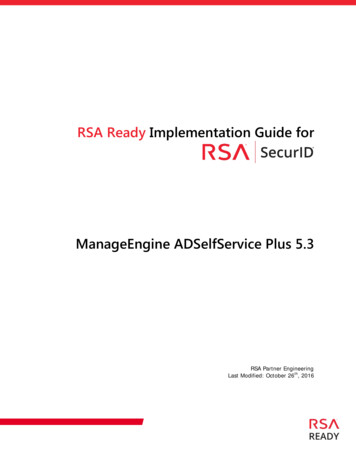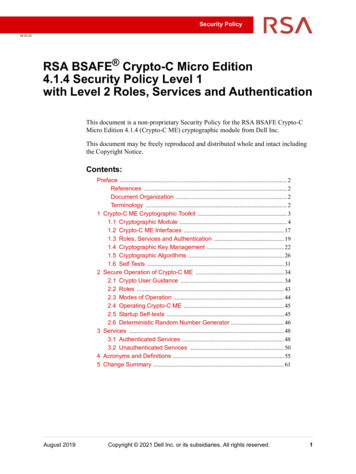
Transcription
Security Policy04.03.22RSA BSAFE Crypto-C Micro Edition4.1.4 Security Policy Level 1with Level 2 Roles, Services and AuthenticationThis document is a non-proprietary Security Policy for the RSA BSAFE Crypto-CMicro Edition 4.1.4 (Crypto-C ME) cryptographic module from Dell Inc.This document may be freely reproduced and distributed whole and intact includingthe Copyright Notice.Contents:Preface . 2References . 2Document Organization . 2Terminology . 21 Crypto-C ME Cryptographic Toolkit . 31.1 Cryptographic Module . 41.2 Crypto-C ME Interfaces . 171.3 Roles, Services and Authentication . 191.4 Cryptographic Key Management . 221.5 Cryptographic Algorithms . 261.6 Self Tests . 312 Secure Operation of Crypto-C ME . 342.1 Crypto User Guidance . 342.2 Roles . 432.3 Modes of Operation . 442.4 Operating Crypto-C ME . 452.5 Startup Self-tests . 452.6 Deterministic Random Number Generator . 463 Services . 483.1 Authenticated Services . 483.2 Unauthenticated Services . 504 Acronyms and Definitions . 555 Change Summary . 61August 2019Copyright 2021 Dell Inc. or its subsidiaries. All rights reserved.1
RSA BSAFE Crypto-C Micro Edition 4.1.4 Security Policy Level 1with Level 2 Roles, Services and AuthenticationPrefaceThis security policy describes how Crypto-C ME meets the relevant securityrequirements of FIPS 140-2 for Level 2 for Roles, Services and Authentication,Level 3 for the Cryptographic Module Specification and Design Assurance, andLevel 1 for all other requirements. The security policy describes how to securelyoperate Crypto-C ME in a FIPS 140-2-compliant manner.Federal Information Processing Standards Publication 140-2 - Security Requirementsfor Cryptographic Modules (FIPS 140-2) details the United States Governmentrequirements for cryptographic modules. For more information about the FIPS 140-2standard and validation program, see the FIPS 140-2 page on the NIST Web site.ReferencesThis document deals only with operations and capabilities of the Crypto-C MEcryptographic module in the technical terms of a FIPS 140-2 cryptographic modulesecurity policy. More information about Crypto-C ME and the entire Dell product lineis available at Dell Support:Document OrganizationThis Security Policy explains the cryptographic module features and functionalityrelevant to FIPS 140-2, and comprises the following sections: This section, provides an overview and introduction to the Security Policy. Crypto-C ME Cryptographic Toolkit describes Crypto-C ME and how it meetsFIPS 140-2 requirements. Secure Operation of Crypto-C ME specifically addresses the requiredconfiguration for the FIPS 140-2 mode of operation. Services lists the functions of Crypto-C ME. Acronyms and Definitions lists the acronyms and definitions used in thisdocument.TerminologyIn this document, the term cryptographic module, refers to the Crypto-C ME FIPS140-2 validated cryptographic module for Overall Security Level 1 with Level 2Roles, Services and Authentication, and Level 3 Cryptographic Module Specificationand Design Assurance.2Preface
RSA BSAFE Crypto-C Micro Edition 4.1.4 Security Policy Level 1with Level 2 Roles, Services and Authentication1 Crypto-C ME Cryptographic ToolkitCrypto-C ME is designed for different processors, and includes various optimizations.Assembly-level optimizations on key processors mean Crypto-C ME algorithms canbe used at increased speeds on many platforms.The Crypto-C ME software development toolkit is designed to enable developers toincorporate cryptographic technologies into applications. It helps to protect sensitivedata as it is stored, using strong encryption techniques to ease integration with existingdata models. Using Crypto-C ME in applications helps provide a persistent level ofprotection for data, lessening the risk of internal, as well as external, compromise.Crypto-C ME offers a full set of cryptographic algorithms including asymmetric keyalgorithms, symmetric key block and stream algorithms, message digests, messageauthentication, and Pseudo Random Number Generator (PRNG) support. Developerscan implement the full suite of algorithms through a single Application ProgrammingInterface (API) or select a specific set of algorithms to reduce code size or meetperformance requirements.Note: When operating in a FIPS 140-2-approved manner, the set of availablealgorithms cannot be changed.This section provides an overview of the cryptographic module and contains thefollowing topics: Cryptographic Module Crypto-C ME Interfaces Roles, Services and Authentication Cryptographic Key Management Cryptographic Algorithms Self Tests.Crypto-C ME Cryptographic Toolkit3
RSA BSAFE Crypto-C Micro Edition 4.1.4 Security Policy Level 1with Level 2 Roles, Services and Authentication1.1 Cryptographic ModuleCrypto-C ME is classified as a multi-chip standalone cryptographic module for thepurposes of FIPS 140-2. As such, Crypto-C ME must be tested on a specific operatingsystem and computer platform. The cryptographic boundary includes Crypto-C MErunning on selected platforms running selected operating systems while configured in“single user” mode. Crypto-C ME is validated as meeting all FIPS 140-2 SecurityLevel 2 for Roles, Services and Authentication, Security Level 3 for DesignAssurance, and Overall Security Level 1 security requirements.Crypto-C ME is packaged as a set of dynamically loaded shared libraries containingthe module's entire executable code. The Crypto-C ME toolkit relies on the physicalsecurity provided by the hosting general purpose computer (GPC) in which it runs. ALevel 2 hosting GPC operational environment should incorporate a Common CriteriaEvaluation Assurance Level 2 (EAL2) operating system and the enclosure should beat least opaque and be either lockable or tamper evident.The following table lists the certification levels sought for Crypto-C ME for eachsection of the FIPS 140-2 specification.Table 14Certification LevelsSection of the FIPS 140-2 SpecificationLevelCryptographic Module Specification3Cryptographic Module Ports and Interfaces1Roles, Services, and Authentication2Finite State Model1Physical SecurityN/AOperational Environment1Cryptographic Key Management1EMI/EMC1Self-Tests1Design Assurance3Mitigation of Other Attacks1Overall1Crypto-C ME Cryptographic Toolkit
RSA BSAFE Crypto-C Micro Edition 4.1.4 Security Policy Level 1with Level 2 Roles, Services and Authentication1.1.1 Laboratory Validated Operating EnvironmentsFor FIPS 140-2 validation, Crypto-C ME is tested by an accredited FIPS 140-2 testinglaboratory on the following operating environments: Apple :–iOS 11.0 running on an iPad Pro 9.7 with an Apple A9X, built withXcode 9 (64-bit)–iOS 10.0 running on an iPhone 5C with Apple A6, built with Xcode 9(32-bit)–macOS 10.13 running on VMware ESXi 6.0.0 on a Mac Pro with anIntel Xeon Processor E5-1650 v2, built with Xcode 7.3 (64-bit), with andwithout PAA–macOS 10.12 running on VMware ESXi 6.0.0 on a Mac Pro with an Intel Xeon Processor E5-1650 v2, built with Xcode 7.3 (32-bit), with and withoutPAA.Canonical – FreeBSD Foundation– Ubuntu 16.04 Long Term Support (LTS) running on a BeagleBoard.org BeagleBone Black with ARM Cortex -A8, built with gcc 4.8 (hard float)(32-bit).FreeBSD 11.2 running on VMware ESXi 6.0.0 on a Cisco UCS C220 M3with Intel Xeon Processor E5-2650, built with Clang 4.0 (64-bit), with andwithout PAA.Google :–Android 8.0 running on a Google Pixel with Qualcomm Snapdragon 821, built with Android NDK r10e and gcc 4.9 (64-bit)–Android 6.0 running on a Google Nexus 5X with Qualcomm Snapdragon808, built with Android NDK r10e and gcc 4.9 (32-bit).HPE–HP-UX 11.31 running on: HP Integrity rx2620 Server with Intel Itanium 2, built with cc B3910BA.06.12 (64-bit) HP Integrity rx2620 Server with Intel Itanium 2, built with cc B3910BA.06.12 (32-bit) HP 9000 rp3410 Server with HP PA-8800, built with HP ANSI-C11.11.12 (64-bit) HP 9000 rp3410 Server with HP PA-8800, built with HP ANSI-C11.11.12 (32-bit).Crypto-C ME Cryptographic Toolkit5
RSA BSAFE Crypto-C Micro Edition 4.1.4 Security Policy Level 1with Level 2 Roles, Services and Authentication IBM :–– AIX 7.2 running on: PowerVM Virtual I/O Server 2.2.6.21 on an IBM Power 8231-E2Bwith an IBM POWER7 , built with XL C/C for AIX (XLC) v11.1(64-bit) PowerVM Virtual I/O Server 2.2.6.21 on an IBM Power 8231-E2B withan IBM POWER7 , built with XLC v11.1 (32-bit).AIX 6.1 running on: PowerVM Virtual I/O Server 2.2.6.21 on an IBM Power 8284-22A withan IBM POWER8 , built with XLC v9.0 (64-bit) PowerVM Virtual I/O Server 2.2.6.21 on an IBM Power 8284-22A withan IBM POWER8, built with XLC v9.0 (32-bit).Microsoft :––Windows 10 Enterprise running on: VMware ESXi 6.0.0 on a Dell PowerEdge R630 with Intel XeonE5-2620, built with Visual Studio 2013 (/MT) (64-bit), with and withoutPAA VMware ESXi 6.0.0 on a Dell PowerEdge R630 with Intel XeonE5-2620, built with Visual Studio 2017 (/MD or /MT) (32-bit), with andwithout PAA VMware ESXi 6.0.0 on a Dell PowerEdge R630 with Intel XeonE5-2620, built with Visual Studio 2013 (/MD) (32-bit), with and withoutPAA.Windows 8.1 Enterprise running on: ––Windows 7 Enterprise SP1 running on: VMware ESXi 6.0.0 on a Cisco UCS C220 M3 with Intel Xeon E5-2650,built with Visual Studio 2005 (/MT) (64-bit), with and without PAA VMware ESXi 6.0.0 on a Cisco UCS C220 M3 with Intel Xeon E5-2650,built with Visual Studio 2010 (/MD or /MT) (32-bit), with and withoutPAA VMware ESXi 6.0.0 on a Cisco UCS C220 M3 with Intel Xeon E5-2650,built with Visual Studio 2005 (/MD or /MT) (32-bit), with and withoutPAA.Windows Server 2016 running on: 6VMware ESXi 6.0.0 on a Cisco UCS C220 M3 with Intel Xeon E5-2650,built with Visual Studio 2013 (/MT) (32-bit), with and without PAA.VMware ESXi 6.0.0 on a Cisco UCS C220 M3 with Intel Xeon E5-2650,built with Visual Studio 2017 (/MD) (64-bit), with and without PAA.Crypto-C ME Cryptographic Toolkit
RSA BSAFE Crypto-C Micro Edition 4.1.4 Security Policy Level 1with Level 2 Roles, Services and Authentication–––Windows Server 2012 R2 Standard running on: VMware ESXi 6.0.0 on a Cisco UCS C220 M3 with Intel Xeon E5-2650,built with Visual Studio 2017 (/MT) (64-bit), with and without PAA VMware ESXi 6.0.0 on a Cisco UCS C220 M3 with Intel Xeon E5-2650,built with Visual Studio 2013 (/MD) (64-bit), with and without PAA VMware ESXi 6.0.0 on a Cisco UCS C220 M3 with Intel Xeon E5-2650,built with Visual Studio 2010 (/MD) (64-bit), with and without PAA.Windows Server 2008 Enterprise R2 SP1 running on: VMware ESXi 6.0.0 on a Cisco UCS C220 M3 with Intel Xeon E5-2650,built with Visual Studio 2010 (/MT) (64-bit), with and without PAA VMware ESXi 6.0.0 on a Cisco UCS C220 M3 with Intel Xeon E5-2650,built with Visual Studio 2005 (/MD) (64-bit), with and without PAA.Windows Server 2008 Enterprise SP2 running on: Oracle :––Solaris 11.4 running on a: Solaris 11 LDOM with SPARC T4-2, built with Sun C 5.13 (64-bit v9) Solaris 11 LDOM with SPARC T4-2, built with Sun C 5.13 (32-bit v8 ) Solaris 11 LDOM with SPARC T4-2, built with Sun C 5.8 (32-bit v8) VMware ESXi 6.0.0 on a Cisco UCS C220 M3 with Intel Xeon E5-2650,built with Sun C 5.13 (64-bit) without PAA.Solaris 10 Update 11 running on: VMware ESXi 6.0.0 on a Cisco UCS C220 M3 with Intel Xeon E5-2650,built with Sun C 5.13 (32-bit) without PAA.Red Hat :– HP Integrity rx2620 Server with Intel Itanium 2, built with Visual Studio2010 (/MT) (64-bit).Enterprise Linux 5.8 running on: z/VM 6.0 running on an IBM zEnterprise 196 with IBM s390 x, builtwith LSB 3.0 and gcc 4.3 (64-bit) z/VM 6.0 on an IBM zEnterprise 196 with IBM s390x, built with LSB 3.0and gcc 4.3 (31-bit).SUSE Software Solutions :–SUSE Linux Enterprise Server 15 running on: VMware ESXi 6.0.0 on a Dell PowerEdge R630 with Intel Xeon E5-2620(64-bit), with and without PAA.Crypto-C ME Cryptographic Toolkit7
RSA BSAFE Crypto-C Micro Edition 4.1.4 Security Policy Level 1with Level 2 Roles, Services and Authentication––SUSE Linux Enterprise Server 12 SP3 running on: PowerVM Virtual I/O Server 2.2.6.21 on an IBM Power 8284-22A withan IBM POWER8, built with gcc 4.8 (64-bit) SoftIron Overdrive 1000 with ARM Cortex-A57, built with gcc 4.8(64-bit) VMware ESXi 6.0.0 running on a Dell PowerEdge R630 with Intel XeonE5-2620, built with LSB 4.0 and gcc 4.4 (64-bit), with and without PAA VMware ESXi 6.0.0 on a Dell PowerEdge R630 with Intel XeonE5-2620, built with LSB 4.0 and gcc 4.4 (32-bit), with and without PAA.SUSE Linux Enterprise Server 11 SP4 running on: PowerVM Virtual I/O Server 2.2.6.21 on an IBM Power 8231-E2B withan IBM POWER7 , built with gcc 3.4 (64-bit) PowerVM Virtual I/O Server 2.2.6.21 on an IBM Power 8231-E2B withan IBM POWER7 , built with gcc 3.4 (32-bit) HP Integrity rx2600 Server with Intel Itanium 2, built with LSB 4.0 andgcc 3.4 (64-bit).Note: All Intel x86 (32-bit) and x86-64 (64-bit) environments were testedwith and without the Intel AES-NI Processor Algorithm Accelerator (PAA).1.1.2 Affirmation of Compliance for other OperatingEnvironmentsAffirmation of compliance is defined in Section G.5, “Maintaining validationcompliance of software or firmware cryptographic modules,” in ImplementationGuidance for FIPS PUB 140-2 and the Cryptographic Module Validation Program.Compliance is maintained in all operational environments for which the binaryexecutable remains unchanged.The Cryptographic Module Validation Program (CMVP) makes no statement as to thecorrect operation of the module or the security strengths of the generated keys if thespecific operational environment is not listed on the validation certificate.Important: Dell affirms compliance of all patch and Service Pack levels withthe same capabilities as the listed operating environments, unless notedotherwise.For Crypto-C ME 4.1.4, Dell affirms compliance for the following operatingenvironments: Apple:–iOS 13 on: 8ARMv8 (64-bit), built with Xcode 9Crypto-C ME Cryptographic Toolkit
RSA BSAFE Crypto-C Micro Edition 4.1.4 Security Policy Level 1with Level 2 Roles, Services and Authentication–iOS 12 on: –iOS 10 on: –x86 64 (64-bit), built with Xcode 7.3.macOS 10.14 on: x86 64 (64-bit), built with Xcode 7.3 x86 (32-bit), built with Xcode 7.3.–macOS 10.12 on x86 64 (64-bit), built with Xcode 7.3.–OS X 10.15 on:––––– ARMv8 (64-bit), built with Xcode 9macOS 10.15 on: –ARMv8 (64-bit), built with Xcode 9 x86 64 (64-bit), built with Xcode 7.3 x86 (32-bit), built with Xcode 7.3.OS X 10.14 on: x86 64 (64-bit), built with Xcode 7.3 x86 (32-bit), built with Xcode 7.3.OS X 10.11 on: x86 64 (64-bit), built with Xcode 7.3 x86 (32-bit), built with Xcode 7.3.OS X 10.10 on: x86 64 (64-bit), built with Xcode 7.3 x86 (32-bit), built with Xcode 7.3.OS X 10.9 on: x86 64 (64-bit), built with Xcode 7.3 x86 (32-bit), built with Xcode 7.3.OS X 10.8 on: x86 64 (64-bit), built with Xcode 7.3 x86 (32-bit), built with Xcode 7.3.Canonical:–Ubuntu 18.04 LTS on: x86 64 (64-bit), built with LSB 4.0 and gcc 4.4 x86 (32-bit), built with LSB 4.0 and gcc 4.4.Crypto-C ME Cryptographic Toolkit9
RSA BSAFE Crypto-C Micro Edition 4.1.4 Security Policy Level 1with Level 2 Roles, Services and Authentication–– x86 64 (64-bit), built with LSB 4.0 and gcc 4.4 x86 (32-bit), built with LSB 4.0 and gcc 4.4.Ubuntu 14.04 LTS on: x86 64 (64-bit), built with LSB 4.0 and gcc 4.4 x86 (32-bit), built with LSB 4.0 and gcc 4.4.CentOS Project:–––––– Ubuntu 16.04 LTS on:CentOS 8.0 on: x86 64 (64-bit), built with Linux Standard Base (LSB) 4.0 and gcc 4.4 x86 (32-bit), built with LSB 4.0 and gcc 4.4.CentOS 7.9 on: x86 64 (64-bit), built with LSB 4.0 and gcc 4.4 x86 (32-bit), built with LSB 4.0 and gcc 4.4CentOS 7.8 on: x86 64 (64-bit), built with LSB 4.0 and gcc 4.4 x86 (32-bit), built with LSB 4.0 and gcc 4.4CentOS 7.7 on: x86 64 (64-bit), built with LSB 4.0 and gcc 4.4 x86 (32-bit), built with LSB 4.0 and gcc 4.4CentOS 7.6 on: x86 64 (64-bit), built with LSB 4.0 and gcc 4.4 x86 (32-bit), built with LSB 4.0 and gcc 4.4CentOS 6.10 on: x86 (32-bit), built with LSB 4.0 and gcc 4.4 x86 64 (64-bit), built with LSB 4.0 and gcc 4.4.Dell –PowerProtect Data Domain OS on: 10x86 64 (64 bit), built with LSB 4.1 and gcc 4.8.3.FreeBSD Foundation–FreeBSD 12.1 on x86 64 (64-bit), built with Clang 4.0–FreeBSD 11.3 on x86 64 (64-bit), built with Clang 4.0–FreeBSD 11.1 on x86 64 (64-bit), built with Clang 4.0.Crypto-C ME Cryptographic Toolkit
RSA BSAFE Crypto-C Micro Edition 4.1.4 Security Policy Level 1with Level 2 Roles, Services and Authentication Google:–Android 9.0 on ARM v8 (64-bit), built with Android NDK r10e and gcc 4.9–Android 7.1.1 on ARM v8 (64-bit), built with Android NDK r10e and gcc 4.9–Android 6.0 on ARMv8 (64-bit), built with Android NDK r10e and gcc 4.9–Android 5.1 on:– ARMv8 (64-bit), built with Android NDK r10e and gcc 4.9 ARMv7 (32-bit), built with Android NDK r10e and gcc 4.9.Android 4.4.4 on ARMv7 (32-bit), built with Android NDK r10e and gcc 4.9.IBM:– AIX v7.1 on: PowerPC (64-bit), built with XLC v11.1 PowerPC (32-bit), built with XLC v11.1.Microsoft:––––Windows 10 Enterprise on: x86 64 (64-bit), built with Visual Studio 2017 (/MD or /MT) x86 64 (64-bit), built with Visual Studio 2013 (/MD) x86 (32-bit), built with Visual Studio 2017 (/MD) x86 (32-bit), built with Visual Studio 2013 (/MT).Windows 10 IoT Enterprise LTSC 2019 on: x86 64 (64-bit), built with Visual Studio 2017 (/MD or /MT) x86 (32-bit), built with Visual Studio 2017 (/MD or /MT).Windows 8.1 Enterprise on: x86 64 (64-bit), built with Visual Studio 2017 (/MD or /MT) x86 64 (64-bit), built with Visual Studio 2013 (/MD or /MT) x86 64 (64-bit), built with Visual Studio 2010 (/MD or /MT) x86 (32-bit), built with Visual Studio 2017 (/MD or /MT) x86 (32-bit), built with Visual Studio2013 (/MD) x86 (32-bit), built with Visual Studio 2010 (/MD or /MT)Windows 7 Enterprise SP1 on: x86 64 (64-bit), built with Visual Studio 2017 (/MD or /MT) x86 64 (64-bit), built with Visual Studio 2010 (/MD or /MT) x86 64 (64-bit), built with Visual Studio 2005 (/MD) x86 (32-bit), built with Visual Studio 2017 (/MD or /MT)Crypto-C ME Cryptographic Toolkit11
RSA BSAFE Crypto-C Micro Edition 4.1.4 Security Policy Level 1with Level 2 Roles, Services and Authentication– x86 (32-bit), built with Visual Studio 2010 (/MD) x86 (32-bit), built with Visual Studio 2005 (/MT).Windows Server 2016 on: –––Windows Server 2012 R2 Standard on: x86 64 (64-bit), built with Visual Studio 2017 (/MD) x86 64 (64-bit), built with Visual Studio 2013 (/MT x86 64 (64-bit), built with Visual Studio 2010 (/MT).Windows Server 2012 Standard on: x86 64 (64-bit), built with Visual Studio 2017 (/MD or /MT) x86 64 (64-bit), built with Visual Studio2013 (/MD or /MT) x86 64 (64-bit), built with Visual Studio 2010 (/MD or /MT).Windows Server 2008 Enterprise R2, SP1 on: –– x86 64 (64-bit), built with Visual Studio 2010 (/MD or /MT) x86 64 (64-bit), built with Visual Studio 2005 (/MD or /MT) x86 (32-bit), built with Visual Studio 2005 (/MD or /MT) Itanium 64-bit, built with Visual Studio 2010 (/MD).Windows Server 2008 SP2 on:––12x86 64 (64-bit), built with Visual Studio 2017 (/MD or /MT).Windows Server 2008 R2 SP1 on: –x86 64 (64-bit), built with Visual Studio 2005 (/MT).Windows Server 2008 Enterprise SP2 on: –x86 64 (64-bit), built with Visual Studio 2017 (/MT).x86 64 (64-bit), built with Visual Studio 2017 (/MD or /MT).Windows XP SP3 on: x86-64 (64-bit), built with Visual Studio 2005 (/MD or /MT). x86 (32-bit), built with Visual Studio 2005 (/MD or /MT).Windows 2003 SP2: x86-64 (64-bit), built with Visual Studio 2005 (/MD or /MT) x86 (32-bit), built with Visual Studio 2005 (/MD or /MT).Windows Vista Enterprise SP1 on: 86-64 (64-bit), built with Visual Studio 2017 (/MD or /MT) 86 (32-bit), built with Visual Studio 2017 (/MD or /MT).Crypto-C ME Cryptographic Toolkit
RSA BSAFE Crypto-C Micro Edition 4.1.4 Security Policy Level 1with Level 2 Roles, Services and Authentication Oracle:–Solaris 11.4 on SPARC v9-T2 (64-bit), built with Sun C 5.13–Solaris 10 Update 11 on: SPARC v9-T4 (64-bit), built with Sun C 5.13 SPARC v9-T2 (64-bit), built with Sun C 5.13 SPARC v8 (32-bit), built with Sun C 5.13 SPARC v8 (32-bit), built with Sun C 5.8 x86 64 (64-bit) built with Sun C 5.13.Red Hat:–––––Enterprise Linux 8.1 on: x86 64 (64-bit), built with LSB 4.0 and gcc 4.4 x86 (32-bit), built with LSB 4.0 and gcc 4.4Enterprise Linux 8.0 on: x86 64 (64-bit), built with LSB 4.0 and gcc 4.4 x86 (32-bit), built with LSB 4.0 and gcc 4.4Enterprise Linux 7.9 on: x86 64 (64-bit), built with LSB 4.0 and gcc 4.4 x86 (32-bit), built with LSB 4.0 and gcc 4.4 PowerPC (64-bit), built with and gcc 4.4 PowerPC (32-bit), built with and gcc 4.4Enterprise Linux 7.8 on: x86 64 (64-bit), built with LSB 4.0 and gcc 4.4 x86 (32-bit), built with LSB 4.0 and gcc 4.4 PowerPC (64-bit), built with and gcc 4.4 PowerPC (32-bit), built with and gcc 4.4Enterprise Linux 7.7 on: x86 64 (64-bit), built with LSB 4.0 and gcc 4.4 x86 (32-bit), built with LSB 4.0 and gcc 4.4 PowerPC (64-bit), built with and gcc 4.4 PowerPC (32-bit), built with and gcc 4.4Crypto-C ME Cryptographic Toolkit13
RSA BSAFE Crypto-C Micro Edition 4.1.4 Security Policy Level 1with Level 2 Roles, Services and Authentication– x86 64 (64-bit), built with LSB 4.0 and gcc 4.4 x86 (32-bit), built with LSB 4.0 and gcc 4.4 PowerPC (64-bit), built with and gcc 4.4 PowerPC (32-bit), built with and gcc 4.4–Enterprise Linux 7.4 on ARMv8 (64-bit), built with gcc 4.8.–Enterprise Linux 6.10 on: x86 64 (64-bit), built with LSB 4.0 and gcc 4.4 x86 (32-bit), built with LSB 4.0 and gcc 4.4SUSE Software Solutions :–––––14Enterprise Linux 7.6 on:SUSE Linux Enterprise Server 15 SP2 on: x86 64 (64-bit), built with LSB 4.0 and gcc 4.4. x86 (32-bit), built with LSB 4.0 and gcc 4.4. PowerPC (64-bit), built with gcc 4.8.SUSE Linux Enterprise Server 15 SP1 on: x86 64 (64-bit), built with LSB 4.0 and gcc 4.4. x86 (32-bit), built with LSB 4.0 and gcc 4.4. PowerPC (64-bit), built with gcc 4.8.SUSE Linux Enterprise Server 15 on: x86 (32-bit), built with LSB 4.0 and gcc 4.4 PowerPC (64-bit), built with and gcc 4.8.SUSE Linux Enterprise Server 12 SP5, SP4, SP2 and SP1 on: ARMv8 (64-bit) built with gcc 4.8 PowerPC (64-bit), built with gcc 4.8 x86 64 (64-bit), built with LSB 4.0 and gcc 4.4 x86 (32-bit), built with LSB 4.0 and gcc 4.4.SUSE Linux Enterprise Server 11 SP4 on: x86 64 (64-bit), built with LSB 4.0 and gcc 4.4 x86 (32-bit), built with LSB 4.0 and gcc 4.4.Crypto-C ME Cryptographic Toolkit
RSA BSAFE Crypto-C Micro Edition 4.1.4 Security Policy Level 1with Level 2 Roles, Services and Authentication1.1.3 Single Operator ModeAn Operator is an individual accessing the cryptographic module or a processoperating the cryptographic module on behalf of the individual.The operating system must enforce a single operator mode of operation, that is,concurrent operators are explicitly excluded.Single-user Operating SystemsThe following supported operating systems are single-user operating systems, so nosteps are required to configure a single operator mode of operation: Apple iOS Google Android.Multi-user Operating SystemsFor the following supported multi-user operating systems, the operating system andhardware enforce a single operator mode of operation by enforcing process isolationand CPU scheduling: Apple OS X and macOS Canonical Ubuntu CentOS Project CentOS FreeBSD Foundation FreeBSD HPE HP-UX IBM AIX Micro Focus SUSE Microsoft Windows Oracle Solaris Red Hat Enterprise Linux.On these operating systems, running on a general purpose computer, dynamicallyloaded shared libraries, including the cryptographic module, are loaded into theaddress space of a process. Each instance of the cryptographic module functionsentirely within the process space of the process containing the module.The single operator for a given instance of the cryptographic module is the identityassociated with the process containing the module. The operating system andhardware enforce process isolation including memory, where keys and intermediatekey data are stored, and CPU scheduling. The writable memory areas of thecryptographic module, data and stack segments, are accessible only to the processcontaining the module.Crypto-C ME Cryptographic Toolkit15
RSA BSAFE Crypto-C Micro Edition 4.1.4 Security Policy Level 1with Level 2 Roles, Services and AuthenticationThe operating system is responsible for multitasking operations so that other processescannot access the address space of the process containing the cryptographic module.Consequently, with the exception of privileged user accounts, no additional steps arerequired to restrict the operating system to a single operator mode of operation. Thatis, concurrent operators are explicitly excluded.Privileged user accountsMulti-user operating systems provide tracing and debugging utilities through whichone process can control another, enabling the controller process to inspect andmanipulate the internal state of its target process.With the exception of privileged user accounts, root user/administrator user, thecontroller process must be running as the same user id as the target process for theseutilities to work. This usage does not contravene the single operator mode of operationas both the controller and target processes are operating on behalf of a single operator.Privileged user accounts are able to use tracing and debugging utilities to target aprocess with a different user id to the controlling process. An operator using thisprivilege to inspect or manipulate a process operating on behalf of another operatorcontravenes the single operator mode of operation.To maintain the single operator mode of operation a privileged user must not use anyof the system tracing and debugging utilities provided by the operating system. In Unix-type operating systems the ptrace system call, the debugger gdb,strace, ftrace and systemtrap must not be used. On Windows equivalent system tracing and debugging utilities must not be used.If necessary, the operating system can be configured to provide only a single operator.That is, login credentials for all user accounts, including privileged user accounts, canbe provided to a single individual only.Server environmentsWhen the module is deployed in a server environment, the server application is theuser of the module. The server application makes the calls to the module. Therefore,the server application is the single user of the module, even when the serverapplication is serving multiple clients.16Crypto-C ME Cryptographic Toolkit
RSA BSAFE Crypto-C Micro Edition 4.1.4 Security Policy Level 1with Level 2 Roles, Services and Authentication1.2 Crypto-C ME InterfacesCrypto-C ME is validated as a multi-chip standalone cryptographic module. Thephysical cryptographic boundary of the module is the case of the general-purposecomputer or mobile device, which encloses the hardware running the module. Thephysical interfaces for Crypto-C ME consist of the keyboard, mouse, monitor,CD-ROM drive, floppy drive, serial ports, USB ports, COM ports, and networkadapter(s).The logical boundary of the cryptographic module is the set of master and resourceshared library files comprising the module: Master shared library:–cryptocme.dll on systems running a Windows operating system–libcryptocme.so on systems running a Solaris, Linux, AIX, FreeBSD, orAndroid, or VxWorks operating system–libcryptocme.sl on systems running an HP-UX operating system–libcryptocme.dylib on systems running an Apple operating system.Resource shared libraries:–ccme base.dll, ccme base non fips.dll, ccme asym.dll,ccme aux entropy.dll, ccme ecc.dll, ccme ecc non fips.dll,ccme ecc accel fips.dll, ccme ecc accel non fips.dll, andccme error info.dll on systems running a Windows operating system.–libccme base.so, libccme base non fips.so,libccme asym.so, libccme aux entropy.so, libccme ecc.so,libccme ecc non fips.so, libccme ecc accel fips.so,libccme ecc accel non fips.so, and libccme error info.soon systems running a Solaris, Linux, AIX, FreeBSD, or Android operatingsystem.–libccme base.sl, libccme base non fips.sl,libccme asym.sl, libccme aux entropy.sl, libccme ecc.sl,libccme ecc non fips.sl, libccme ecc accel fips.sl,libccme ecc accel non fips.sl, and libccme error info.slon systems running an HP-UX operating system.–libccme base.dylib, libccme
RSA BSAFE Crypto-C Micro Edition 4.1.4 Security Policy Level 1 with Level 2 Roles, Services and Authentication This document is a non-proprietary Security Policy for the RSA BSAFE Crypto-C Micro Edition 4.1.4 (Crypto-C ME) cryptographic module from Dell Inc. This document may be freely reproduced and distributed whole and intact including
